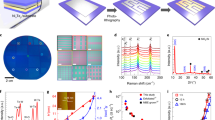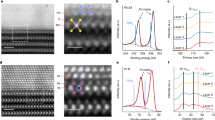Abstract
High Schottky barrier heights at metal–semiconductor junctions due to Fermi-level pinning can degrade the performance of electronic devices and increase their energy consumption. Van der Waals contacts between metals and two-dimensional semiconductors without Fermi-level pinning are theoretically possible, but have not been achieved due to the presence of interactions such as interface defects and orbital overlap. Here we show that interaction- and defect-free van der Waals contacts can be formed between a range of metals and two-dimensional semiconductors via a metal deposition process that uses a selenium buffer layer. Our contacts obey the Schottky–Mott rule and have a Fermi-level pinning of –0.91. A comparison between the van der Waals contacts and typical direct metal contacts reveals differences in interface gap distances, band bending and electrical characteristics. Using gold van der Waals contacts, we fabricate p-type tungsten diselenide field-effect transistors that exhibit stable operation with on/off ratio of 106, mobility of 155 cm2 (V s)–1, contact resistance of 1.25 kΩ μm and Schottky barrier height of 60 meV.
This is a preview of subscription content, access via your institution
Access options
Access Nature and 54 other Nature Portfolio journals
Get Nature+, our best-value online-access subscription
$29.99 / 30 days
cancel any time
Subscribe to this journal
Receive 12 digital issues and online access to articles
$119.00 per year
only $9.92 per issue
Buy this article
- Purchase on Springer Link
- Instant access to full article PDF
Prices may be subject to local taxes which are calculated during checkout





Similar content being viewed by others
Data availability
The data that support the findings of this study are available from the corresponding authors upon reasonable request.
References
Tung, R. T. The physics and chemistry of the Schottky barrier height. Appl. Phys. Rev. 1, 011304 (2014).
Allain, A., Kang, J., Banerjee, K. & Kis, A. Electrical contacts to two-dimensional semiconductors. Nat. Mater. 14, 1195–1205 (2015).
Schottky, W. Halbleitertheorie der Sperrschicht. Naturwissenschaften 26, 843 (1938).
Hasegawa, H. & Sawada, T. On the electrical properties of compound semiconductor interfaces in metal/insulator/ semiconductor structures and the possible origin of interface states. Thin Solid Films 103, 119–140 (1983).
Kong, L. et al. Doping-free complementary WSe2 circuit via van der Waals metal integration. Nat. Commun. 11, 1866 (2020).
Wang, Y. et al. Does p-type ohmic contact exist in WSe2–metal interfaces? Nanoscale 8, 1179–1191 (2016).
Liu, Y., Stradins, P. & Wei, S. H. Van der Waals metal-semiconductor junction: weak Fermi level pinning enables effective tuning of Schottky barrier. Sci. Adv. 2, e1600069 (2016).
Liu, Y., Huang, Y. & Duan, X. Van der Waals integration before and beyond two-dimensional materials. Nature 567, 323–333 (2019).
Kim, C. et al. Fermi level pinning at electrical metal contacts of monolayer molybdenum dichalcogenides. ACS Nano 11, 1588–1596 (2017).
Jang, J. et al. Clean interface contact using a ZnO interlayer for low-contact-resistance MoS2 transistors. ACS Appl. Mater. Interfaces 12, 5031–5039 (2020).
Mleczko, M. J. et al. Contact engineering high-performance n-type MoTe2 transistors. Nano Lett. 19, 6352–6362 (2019).
Stanford, M. G. et al. High conduction hopping behavior induced in transition metal dichalcogenides by percolating defect networks: toward atomically thin circuits. Adv. Funct. Mater. 27, 1702829 (2017).
Zhou, W. et al. Intrinsic structural defects in monolayer molybdenum disulfide. Nano Lett. 13, 2615–2622 (2013).
Santosh, K. C., Longo, R. C., Addou, R., Wallace, R. M. & Cho, K. Impact of intrinsic atomic defects on the electronic structure of MoS2 monolayers. Nanotechnology 25, 375703 (2014).
Hong, J. et al. Exploring atomic defects in molybdenum disulphide monolayers. Nat. Commun. 6, 6293 (2015).
Liu, Y. et al. Approaching the Schottky–Mott limit in van der Waals metal–semiconductor junctions. Nature 557, 696–700 (2018).
Wang, Y. et al. Van der Waals contacts between three-dimensional metals and two-dimensional semiconductors. Nature 568, 70–74 (2019).
Mattox, D. M. The Foundations of Vacuum Coating Technology (Springer, 2003).
Bondi, A. Van der Waals volumes and radii. J. Phys. Chem. 68, 441–451 (1964).
Bitla, Y. & Chu, Y. H. Van der Waals oxide heteroepitaxy for soft transparent electronics. Nanoscale 12, 18523–18544 (2020).
Desai, S. B. et al. Gold-mediated exfoliation of ultralarge optoelectronically-perfect monolayers. Adv. Mater. 28, 4053–4058 (2016).
Addou, R. & Wallace, R. M. Surface analysis of WSe2 crystals: spatial and electronic variability. ACS Appl. Mater. Interfaces 8, 26400–26406 (2016).
Sezen, H. & Suzer, S. Communication: enhancement of dopant dependent X-ray photoelectron spectroscopy peak shifts of Si by surface photovoltage. J. Chem. Phys. 135, 141102 (2011).
Smyth, C. M., Addou, R., McDonnell, S., Hinkle, C. L. & Wallace, R. M. Contact metal–MoS2 interfacial reactions and potential implications on MoS2-based device performance. J. Phys. Chem. C 120, 14719–14729 (2016).
Qu, D. et al. Carrier-type modulation and mobility improvement of thin MoTe2. Adv. Mater. 29, 1606433 (2017).
Shen, P. C. et al. Ultralow contact resistance between semimetal and monolayer semiconductors. Nature 593, 211–217 (2021).
Huang, J. et al. Stable electrical performance observed in large-scale monolayer WSe2(1-x)S2x with tunable band gap. Nanotechnology 27, 13LT01 (2016).
Ramos, R., Cunge, G., Touzeau, M. & Sadeghi, N. Measured velocity distribution of sputtered Al atoms perpendicular and parallel to the target. J. Phys. D 41, 152003 (2008).
Lim, J. Y. et al. Homogeneous 2D MoTe2 p–n junctions and CMOS inverters formed by atomic-layer-deposition-induced doping. Adv. Mater. 29, 1701798 (2017).
Popov, I., Seifert, G. & Tománek, D. Designing electrical contacts to MoS2 monolayers: a computational study. Phys. Rev. Lett. 108, 156802 (2012).
Fan, Z. Q. et al. In-plane Schottky-barrier field-effect transistors based on 1T/2H heterojunctions of transition-metal dichalcogenides. Phys. Rev. B 96, 165402 (2017).
Zhong, H. et al. Interfacial properties of monolayer and bilayer MoS2 contacts with metals: beyond the energy band calculations. Sci. Rep. 6, 21786 (2016).
Gao, J. & Gupta, M. Titanium disulfide as Schottky/ohmic contact for monolayer molybdenum disulfide. npj 2D Mater. Appl. 4, 26 (2020).
Min, K. A., Park, J., Wallace, R. M., Cho, K. & Hong, S. Reduction of Fermi level pinning at Au–MoS2 interfaces by atomic passivation on Au surface. 2D Mater. 4, 015019 (2017).
English, C. D., Shine, G., Dorgan, V. E., Saraswat, K. C. & Pop, E. Improved contacts to MoS2 transistors by ultra-high vacuum metal deposition. Nano Lett. 16, 3824–3830 (2016).
Zhang, R., Drysdale, D., Koutsos, V. & Cheung, R. Controlled layer thinning and p-type doping of WSe2 by vapor XeF2. Adv. Funct. Mater. 27, 1702455 (2017).
Shokouh, S. H. H. et al. High-performance, air-stable, top-gate, p-channel WSe2 field-effect transistor with fluoropolymer buffer layer. Adv. Funct. Mater. 25, 7208–7214 (2015).
Fang, H. et al. High-performance single layered WSe2 p-FETs with chemically doped contacts. Nano Lett. 12, 3788–3792 (2012).
Chuang, H. J. et al. High mobility WSe2 p- and n-type field-effect transistors contacted by highly doped graphene for low-resistance contacts. Nano Lett. 14, 3594–3601 (2014).
Allain, A. & Kis, A. Electron and hole mobilities in single WSe2. ACS Nano 8, 7180–7185 (2014).
Movva, H. C. P. High-mobility holes in dual-gated WSe2 field-effect transistors. ACS Nano 9, 10402–10410 (2015).
Yamamoto, M., Nakaharai, S., Ueno, K. & Tsukagoshi, K. Self-limiting oxides on WSe2 as controlled surface acceptors and low-resistance hole contacts. Nano Lett. 16, 2720–2727 (2016).
Xu, S. et al. Universal low-temperature ohmic contacts for quantum transport in transition metal dichalcogenides. 2D Mater. 3, 021007 (2016).
Chen, C. H. et al. Hole mobility enhancement and p-doping in monolayer WSe2 by gold decoration. 2D Mater. 1, 034001 (2014).
Chuang, H. J. et al. Low-resistance 2D/2D ohmic contacts: a universal approach to high-performance WSe2, MoS2, and MoSe2 transistors. Nano Lett. 16, 1896–1902 (2016).
Smyth, C. M., Addou, R., McDonnell, S., Hinkle, C. L. & Wallace, R. M. WSe2-contact metal interface chemistry and band alignment under high vacuum and ultra high vacuum deposition conditions. 2D Mater. 4, 025084 (2017)
Kim, H. G. & Choi, H. J. Thickness dependence of work function, ionization energy, and electron affinity of Mo and W dichalcogenides from DFT and GW calculations. Phys. Rev. B 103, 085404 (2021).
Michaelson, H. B. The work function of the elements and its periodicity. J. Appl. Phys. 48, 4729 (1977).
Acknowledgements
This work was partially supported by an Industry–Academy joint research programme between Samsung Electronics and Yonsei University. This work was supported by the National Research Foundation of Korea (NRF) grant funded by the Korean government (grant no. 2017R1A5A1014862; SRC programme, vdWMRC center). This work was supported by the NRF grant funded by the Government of Korea (MSIP) (no. 2021M3H4A1A03052566).
Author information
Authors and Affiliations
Contributions
G.K. conceived the research and designed the experiments with the help of M.-H.C. G.K., Y.-H.C., H. Kim and J.J. contributed to the device fabrication and setting the equipment. G.K., Y.-H.C., H. Kim, J.J., M.B. and H. Kwon performed the experiments and data analysis. K.J. contributed to the DFT calculations. H.L., J.A. and E.L. made a significant contribution to the STEM measurement and analysis. The manuscript was written by G.K. and revised by M.-H.C. All the experiments and analyses were supervised by M.-H.C.
Corresponding authors
Ethics declarations
Competing interests
The authors declare no competing interests.
Peer review
Peer review information
Nature Electronics thanks the anonymous reviewers for their contribution to the peer review of this work.
Additional information
Publisher’s note Springer Nature remains neutral with regard to jurisdictional claims in published maps and institutional affiliations.
Supplementary information
Supplementary Information
Supplementary Figs. 1–18.
Rights and permissions
About this article
Cite this article
Kwon, G., Choi, YH., Lee, H. et al. Interaction- and defect-free van der Waals contacts between metals and two-dimensional semiconductors. Nat Electron 5, 241–247 (2022). https://doi.org/10.1038/s41928-022-00746-6
Received:
Accepted:
Published:
Issue Date:
DOI: https://doi.org/10.1038/s41928-022-00746-6
This article is cited by
-
Modulating p-type doping of two dimensional material palladium diselenide
Nano Research (2024)
-
Optimizing 2D-metal contact in layered Tin-selenide via native oxide modulation
Nano Research (2024)
-
Van der Waals Heterostructure Engineering for Ultralow-Resistance Contact in 2D Semiconductor P-Type Transistors
Journal of Electronic Materials (2024)
-
The Roadmap of 2D Materials and Devices Toward Chips
Nano-Micro Letters (2024)
-
Wafer-scale and universal van der Waals metal semiconductor contact
Nature Communications (2023)



